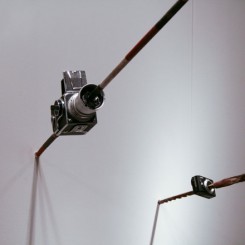If you want a picture of the future of art fairs, imagine a boot stomping a human face (especially about the eyes)—forever. It might seem a bit much to bring up Orwell in relation to Art Basel Miami Beach, but with the fair’s recent acquisition of Art HK, the Swiss company has moved from the institutional to the despotic. The Miami Beach Convention Center, originally built in 1957, has all the charm of the Death Star. Fairgoers blanched by the harsh lighting aren’t allowed to bring in their own drinks, having to choose from $4 bottles of water or a $20 flute of Champagne. And did you know that art fairs, like, totally commodify the creative impulse?
As you might have guessed, the fair itself was bloated with blue-chip works like so much botox into the faces of the collectors. (Excepting of course the Rubells, who can text and powerwalk at the same time. “It gets windy whenever they come through,” said local artist Jim Drain.) With all the tact of a tradeshow, it manages to resemble a museum (which, as Adorno tells us, is only a few letters away from mausoleum). This year, this thanatos came in the form of Cy Twombly, whose entire catalogue raisonné seemed to be on sale.
There was much less Chinese art than recent years, another signal of the fair’s move into Hong Kong — and with that, the homogeneity that comes with a global brand. Nobody wanted the looming Hong Kong fair to block out their Miami sun. Concetta Duncan, a media liaison for the fair, put it briefly, “We’re not focusing on Hong Kong right now.” Neither, it seems, were the galleries. Pace had two Zhang Huan ash paintings, one of which they sold in the low six figures. In pan-oriental mode, the gallery responded to my question about Chinese artists by bringing up the Korean Lee Ufan, which hadn’t moved yet but was the target of “tremennnndous interest.”
Long March Space sold MadeIn’s appropriation of Vermeer’s “Girl with a Pearl Earring” for $50,000. They also had a nice sculpture and painting by Liu Wei. ShanghART’s booth had a selection of Birdhead photographs that sold on the first day. Also on display was MadeIn’s new series “Focus,” in which spears pierce digital cameras, and several of Zhang Enli’s works, who is coasting on the strength of a recent show at Hauser & Wirth. Even though the gallery fared well, offloading one of the MadeIn pieces for $30,000 and a Zhang Enli for $37,000, everybody seemed to be suffering from jet lag. Lorenz Helbling motioned to a Chen Xiaoyun photograph, “Dusk of Mr. Chen” (2007), which features a man’s head buried in coal, and commented, “I feel like this guy.”
Blum and Poe, which had Zhang Huan’s “49 Days No.1” (2011) installed at the Bass museum as part of the Art Public section, almost completely sold out the booth in the first hour. James Cohan had a nice time, moving a Fred Tomaselli for $500,000. This price stands on the shoulders of a recent Christie’s auction where the artist’s record was shattered with a $1.65 million sale. As to the provenance of the collectors, Jane Cohan, director of press relations, said that they were seeing a lot of Americans, South Americans, and Italians.
Art Basel Miami Beach’s international makeup mirrors both the contemporary art world and the population of Miami, most of which is from somewhere else. Emmanuel Perrotin, who has a space in Wynwood but keeps it shuttered 51 weeks out of the year, sold a Murakami bear sculpture for $700,000 to a pair of French collectors who live in Miami but finance a gallery in China. This acquisition didn’t come as good news to Pharrell Williams, who also wanted the sculpture and is quoted on Artinfo.com as being “pissed off.”

MadeIn Company, “Focus,” camera and aboriginal spear, dimensions
variable, 2011 (ShanghART Gallery).
没顶公司, “聚焦,” 相机, 长矛, 2011 (香格纳画廊)。
It was business as usual for the other supergalleries. I didn’t even step into Gagosian, for fear of being trampled. Marian Goodman had a critically strong booth. A selection of Gerhard Richter photographs and a series by Anri Sala offered a counterpoint to the towering Mark Handforth and Rob Pruitts over at Gavin Brown’s Enterprise.
Those that strayed from the formula, showing challenging work in order to lure museums or to challenge the institution of the fair, might not have had great sales, but made the fair bearable. Team Gallery focused on the little-known sculptor Ross Knight. There was a large Ryan McGinley hanging on the outside of the booth that served mainly to lure people in. “I don’t think anybody’s going to buy that,” said an employee of the gallery, in regards to the wall-sized photograph of a menstruating woman’s anus paired with a bewildered fowl.
Greene Naftali eschewed the normal booth structure, devoting a large portion of their space to a Guyton/Walker installation from 2009. The Sao Paulo gallery Mendes Wood handed their booth over to Paulo Nazareth, who spent the weekend selling bananas and posing for pictures.
The most fun was had outside the fair. If I had to do it again, I’d skip every fair except NADA, and then NADA for the parties. The Artforum dinner at the Wolfsonian Museum had the best cheese and charcuterie. I stumbled with the sterling tongs as I tried to transfer a blossom of prosciutto onto my plate. Next to me was a very bemused Gabriel Orozco, who simply said, “It’s easier to do it this way,” before reaching in with his fingers. That this encounter would never have happened within the convention center — but would never have happened without the fair — represents my shellshocked ambivalence. I’m so, so happy that the weekend is over, and I can’t wait until next year.



